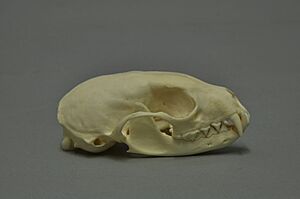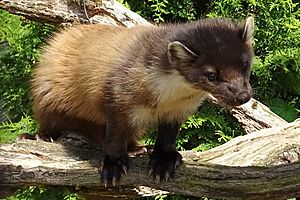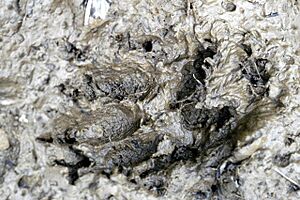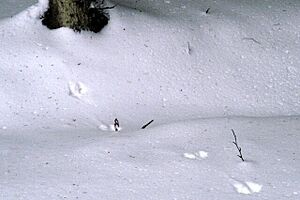European pine marten facts for kids
Quick facts for kids European pine marten |
|
|---|---|
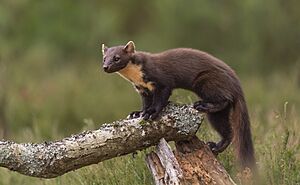 |
|
| Conservation status | |
| Scientific classification | |
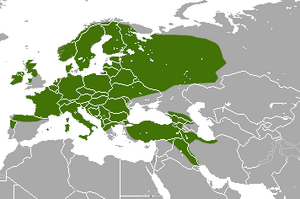 |
|
| European pine marten range (green – native, red – introduced) |
|
| Synonyms | |
|
Mustela martes Linnaeus, 1758 |
The European pine marten (Martes martes) is a wild animal found across much of Europe, Asia Minor, the Caucasus region, and parts of the Middle East. It's also called the pine marten. This animal belongs to the mustelid family, which includes weasels and badgers. The European pine marten is currently listed as a species of Least Concern by the IUCN Red List, meaning it is not at high risk of extinction. Sometimes, people also call it the baum marten or sweet marten.
Contents
What Does a Pine Marten Look Like?
The European pine marten has fur that is usually light to dark brown. In summer, its fur is short and rough. In winter, it grows longer and feels silkier. A special mark on its throat is a cream or yellow "bib."
Its body can be up to 53 centimeters (about 21 inches) long. Its bushy tail adds another 25 centimeters (about 10 inches). A pine marten usually weighs around 1.5 to 1.7 kilograms (about 3.3 to 3.7 pounds). Males are a bit bigger than females. These animals have excellent senses of sight, smell, and hearing.
Where Do Pine Martens Live?
Pine Martens in Scotland, Ireland, England, and Wales
For many years, the European pine marten was mostly found in northwestern Scotland. A study in 2012 showed that they have spread. They moved north into Sutherland and Caithness. They also spread southeast from the Great Glen into other areas like Moray and Aberdeenshire. Some have even reached the Central Belt and islands like Skye.
In England, people thought the European pine marten had died out. But in 2010, scientists found animal droppings in Northumberland. This suggested that martens might be returning from Scotland. Or, a small group might have been living there all along without anyone knowing.
In Cumbria, many people reported seeing pine martens. In 2011, DNA tests on droppings confirmed their presence. Then, in October 2022, photos of a pine marten were taken in Grizedale Forest.
In July 2015, a photographer saw a European pine marten in Shropshire. This was the first confirmed sighting in England in over 100 years. More sightings have happened, and young martens were seen in 2019. This means a group of martens is now breeding there. In 2017, a camera trap filmed a live marten in the North York Moors. In 2018, the first video of a marten in Northumberland was captured.
Pine martens were confirmed to be breeding in the New Forest in Southern England in 2021. In September 2022, a pine marten was seen in London for the first time in a century. This was caught on camera by the Zoological Society of London. In 2024, the Kent Wildlife Trust started a project to see if they could bring pine martens back to South East England.
There is a small group of European pine martens in Wales. In 2007, droppings found in Cwm Rheidol forest were confirmed to be from a pine marten. In 2012, a male marten was found after being hit by a car near Newtown, Powys. This was the first proof of the species in Wales since 1971.
The Vincent Wildlife Trust (VWT) has started to help these animals in mid-Wales. In autumn 2015, they caught 20 pine martens in Scotland. These martens came from areas where there were many healthy martens. They were then moved and released in mid-Wales. All the martens had radio collars. This allowed scientists to track their movements and see where they made their homes. In autumn 2016, the VWT released another 20 pine martens. They hoped to create a strong, self-sustaining group.
Because these projects worked well, 35 more pine martens were released between 2019 and 2021. They went to the Forest of Dean in South West England. Martens were last seen there in 1860. The hope is that these groups will join with the growing population in Wales. By 2023, their numbers were thought to be almost 60.
The European pine marten is still quite rare in Ireland. However, their numbers are growing and they are spreading. They used to be mainly in the west and south, like the Burren. But their numbers have grown a lot in the Midlands recently. A study in 2015 showed that pine martens were found in all counties of Northern Ireland. Bringing them back has caused some debate.
How Pine Martens Live and Behave
The European pine marten is the only mustelid with claws that can partly pull back. This helps them climb trees and run on branches. They are also quite fast on the ground. They are mostly active at night and at dusk.
They have small, round ears that are very sensitive. Their sharp teeth are good for eating small mammals, birds, insects, and frogs. They also eat dead animals. Pine martens are known to eat berries, fruits, bird eggs, nuts, and honey.
A European pine marten protects its own area, called a home range. They mark their area by leaving their droppings. Their droppings are black and twisted.
The return of the European pine marten in Ireland has helped reduce the number of invasive grey squirrels. When the pine marten population grows and meets the grey squirrel areas, the grey squirrel numbers quickly drop. Then, the red squirrel population starts to grow again. Grey squirrels spend more time on the ground than red squirrels. Red squirrels have lived with pine martens for a long time. This means grey squirrels are more likely to meet a pine marten and become prey.
Life Cycle and Reproduction
A European pine marten has lived for up to 18 years in zoos. But in the wild, the oldest recorded was 11 years old. Most live for 3 to 4 years in the wild. They can start having babies when they are 2 to 3 years old.
Mating happens in July and August. The young are usually born in late March or early April. The mother carries them for about a month after the egg settles in her womb. A litter usually has one to five babies. Young pine martens weigh about 30 grams (about 1 ounce) when they are born. The babies start coming out of their dens around 7 to 8 weeks old. They can leave the den completely around 12 to 16 weeks after birth.
Who Hunts Pine Martens?
Larger animals and birds of prey hunt European pine martens. These include the Eurasian lynx, wolverine, red fox, golden eagle, and Eurasian eagle owl. Young pine martens are especially at risk.
What Threats Do Pine Martens Face?
Humans are the biggest danger to the European pine marten. They can be harmed when people try to control other animals that are seen as pests. Or, if they eat farm animals or live in buildings where people live. Martens can also be affected by losing their forest homes.
Illegal hunting, poisoning, and losing their habitat have caused a big drop in pine marten numbers. In some places, their very fine fur was also highly valued. In the UK, European pine martens and their dens are fully protected by law. This protection comes from the Wildlife and Countryside Act 1981 and the Environmental Protection Act 1990.
Pine Martens in Culture
The European pine marten is one of the national symbols of Croatia. It appears on the Croatian euro coins. Before the euro, the pine marten was on the Croatian kuna coins. The word "kuna" actually means "marten" in the Croatian language.
See also
 In Spanish: Martes martes para niños
In Spanish: Martes martes para niños
- Marturina



